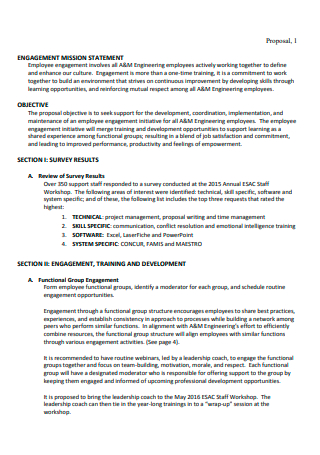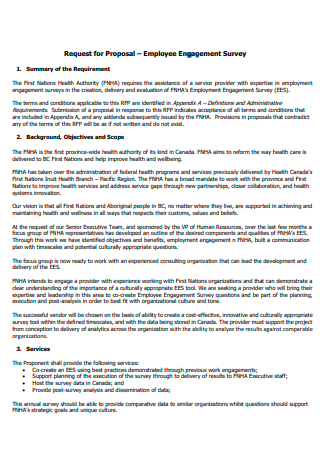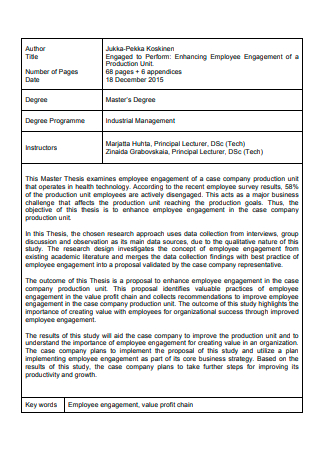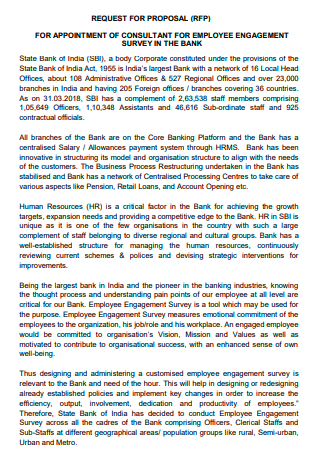10+ Sample Employee Engagement Proposal
-

Employee Engagement Programme Proposal
download now -

Employee Engagement Proposal Example
download now -

Standard Employee Engagement Proposal
download now -

Employee Engagement Survey Software Proposal
download now -

Employee Engagement Survey and Services Proposal
download now -

Employee Engagement Survey Proposal
download now -

Employee Engagement Project Proposal
download now -

Employee Engagement Survey Consultancy Assignment Proposal
download now -

Employee Engagement Survey Plat Form Services Proposal
download now -

Employee Engagement Proposal in PDF
download now -

Consultant Employee Engagement Survey Proposal
download now
FREE Employee Engagement Proposal s to Download
10+ Sample Employee Engagement Proposal
What Is an Employee Engagement Proposal?
Benefits of Employee Engagement
Tips To Improve Employee Engagement
How To Create a Plan For Your Employee Engagement
FAQs
Why do employee benefits boost long-term engagement?
What is one of the key benefits of workforce engagement?
How do leaders motivate employees?
What Is an Employee Engagement Proposal?
An employee engagement proposal is a method that an organization must develop to identify and prioritize its actions, as well as to be able to pinpoint quick and simple changes to explain to its employees that the organization is committed to implementing an action plan in response to any form of employee engagement feedback. According to the statistics, 51% of employees are disengaged at work, while 13% are actively disengaged.
Benefits of Employee Engagement
Every manager desires to lead personnel devoted and invested in their jobs. In other words, they want an engaged workforce. However, why is this so essential? What are the advantages of engaging employees? Numerous factors influence employee engagement. Engagement is influenced by various elements, including how satisfied employees are with their jobs, their relationships with coworkers and management, and the frequency with which they feel their contributions are valued. When employees are genuinely engaged, teams improve from good to outstanding. Challenges become chances, outcomes become accomplishments, and individuals give their all. Employee engagement is crucial for a simple reason: it has many advantages. These include benefits for employees and teams, managers, and the organization.
Tips To Improve Employee Engagement
There are many ways to get employees more interested in their work. Some are aimed at long-term goals, while others are quick wins for your employees and your business that can be seen right away. Before you can make a difference and get accurate results, you need to know what makes employees feel engaged. Here are five things you could do.
1. Live your mission, vision, and values
What is your organization’s mission? What do you internally value? Employees want to know that the association they are a part of has a broader perspective and gives them or others purpose. A business that integrates its principles into daily operations fosters a more meaningful workplace for its employees. However, merely publishing your goal statement on your website is insufficient. To obtain genuine buy-in, you must incorporate your company’s long-term vision and core values into its business operations. Employees are motivated and involved when they have a thorough understanding of the company’s basic principles and how they affect the organization.
2. Concentrate on boarding
Even in the job, first impressions are essential. The onboarding procedure establishes the employee’s perspective of the firm and role. Onboarding employees is a terrific method to introduce them to your organization’s purpose, vision, and values. It also assists students in comprehending how they fit into the bigger picture. Utilize the onboarding process to demonstrate to new hires what makes your company’s culture unique and how they contribute to the team and organization. Provide information pertinent to their role and establish expectations for future interactions with other team members.
3. Educate employees to excel in their roles and beyond.
Instead of giving employees reasons to seek growth possibilities elsewhere, please encourage them to thrive within your organization. As described previously, commitment is one of the three pillars of employee engagement. Employees desire to feel supported and cared for by their bosses and leaders. It is a vital characteristic of a good manager. Ultimately, mutual regard fosters genuine relationships that illuminate a road to shared accomplishment. High-performance organizations are aware that manager support for employee development is essential for maximizing employee potential.
4. Recognize and reward your employees
To feel completely involved in the organization, employees must sense that their colleagues, managers, and leaders sincerely value their contributions. Recognition is also what motivates people to accomplish their best and makes them appreciate their profession. Reward and recognition are not standardized. To maximize your efforts and take into account the preferences of your employees, you must learn how they want to receive an acknowledgment.
5. Communicate feedback the right way
Companies with effective internal communications have satisfied employees. They are well-informed, acknowledged, and heard, and they collaborate effectively with other teams. This is made feasible by fostering a culture of consistent, two-way communication. When your organization sets open communication as a core value and exemplifies it from the top down, your employees will seek regular feedback and communicate openly in response.
How To Create a Plan For Your Employee Engagement
Frequently, companies invest time and resources in employee engagement strategies without recognizing their strategic significance, for instance, introducing a trendy employee engagement effort without knowing whether workers can benefit from it or investing money in a program before determining whether the employee is interested in participating. Simply claiming to increase employee engagement is insufficient; you must build a clear, concrete employee engagement plan to achieve this goal! If you’re still curious, here are the steps to creating a plan for employee engagement.
1. Maintain Your Core Values
Your company culture should revolve around your core principles, which should be communicated to every employee. Your company’s core principles should describe what matters to your team and the ideas you will aim to uphold as you grow. Employees must have a feeling of belonging to your firm to be fully engaged, and a code of values will assist them in doing so. By continuously communicating your core values to the entire team, you will foster a cohesive, positive work environment and encourage employees to develop an emotional connection to the firm.
2. Provide career paths and opportunities for advancement.
Ninety-four percent of employees say they would remain at their jobs longer if they believed their employer was genuinely committed to their careers. Providing employees with an opportunity to expand their skill set keeps them engaged, and having goals keeps them motivated. In addition, learning and development programs reflect that you appreciate your employees as individuals; you choose to consistently invest in your people instead of replacing them with prospects who possess the desired abilities.
3. Recognize Top Performers
Employees are engaged when they believe their job contributes to achieving the organization’s long-term objectives. Regularly demonstrating recognition and appreciation for employees’ achievements is a simple gesture that goes a long way toward making them feel valued. Reward top performers for their accomplishments with a cash incentive, a free day off, a gift card to their favorite lunch location, or a gift voucher for a massage – whatever makes sense for your team and matches your core values. In addition, providing a platform for employees to recognize their peers; feeling valued and appreciated by their team members will increase employee engagement.
4. Promote Transparency
Bringing employees into the fold as much as feasible is a highly successful method for employee engagement. If your employees are unaware of what is occurring behind the scenes, they cannot devote their whole efforts to the organization. In addition, if they perceive that they are being excluded on purpose, they may begin to mistrust management and lose faith in leadership. You have every right to be discreet when situations develop, and priorities shift, but you should inform team members as quickly as possible about decisions that directly affect them.
5. Allow for Honest Comment
This method is dual-pronged. Create a platform or strategy that allows employees to voice their opinions and ask pertinent inquiries. This will generally be your HR department, but the C-suite should also be accessible to all employees, even if only a few days every quarter and by appointment. Second, leverage the feedback of your staff. Nothing can frustrate and disconnect your employees more quickly than the perception that they are wasting their time by presenting information that is vital to them. Consider the feedback of your team members and act accordingly.
6. Hold Employees Accountable
Engaged employees are prepared to go above and beyond, but you shouldn’t always expect them to operate at an above-average rate. As they are not the only team member, ensure that they are not likely to work on behalf of their teammates. Employee burnout may result from relying only on the efforts of your most engaged staff.
7. Revamp Your Office Space
Your office atmosphere plays a significant impact on your employee’s engagement. You’ve likely observed that cubicles are uncommon in the modern workplace due to their isolationist nature. Siloing personnel impedes communication and collaboration, two crucial elements of business success. Redesign your floor arrangement so that staff may communicate with one another more frequently. By establishing solid relationships with their coworkers, employees will develop a sense of camaraderie and belonging, which is essential for fostering an engaged workforce.
FAQs
Why do employee benefits boost long-term engagement?
Because they are invested in their work, and their performance is essential to them. They are accountable for their contribution and aligned with the team and business goals. This results in greater team productivity.
What is one of the key benefits of workforce engagement?
Workgroups with greater levels of engagement earn 10 percent higher customer ratings and 20 percent more revenue than those with lower levels of engagement. Workgroups in the top quartile of engagement are more present and productive; their average productivity is 17 percent higher, and their profitability is 21 percent greater.
How do leaders motivate employees?
Great leaders motivate their teams by combining a positive mindset, behavior, and communication. Great managers always push their people to grow professionally, remain optimistic in all situations, and inspire and drive the team.
Encouraging employees to keep a healthy work-life balance demonstrates your concern as an employer. Do not contact them on weekends or when they are on vacation. People require time to unplug entirely from work. And someone who works from home should not be on call around the clock. Respect for people’s personal space and employee engagement will rapidly improve. Check out the article’s employee engagement proposal samples and templates if you would like to view additional examples and forms.
